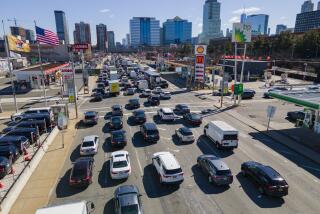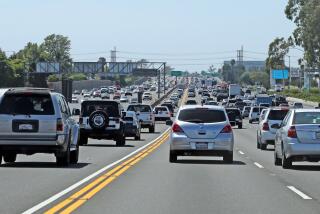London Mayor Plans to Curb Traffic Gridlock by Taxing It
- Share via
LONDON — Anyone who has tried to get through the streets of London on four wheels knows the meaning of gridlock. Traffic moves so slowly that drivers can conduct entire business meetings, do a full makeup job and read the tabloids cover to cover.
In his efforts to reduce this traffic and increase funds for public transit, Mayor Ken Livingstone has announced that people will have to pay a $7-a-day “congestion charge” to drive their cars into central London, where the average daytime road speed is 7 mph.
The plan, announced this month, will take effect in January 2003 and aims to reduce traffic in central London by 15%. It is expected to bring in about $280 million a year, which will be poured into improvements of the notoriously slow buses and unbearably crowded subways.
“We have to reduce congestion because it’s become intolerable in central London,” said Bibi Berki, a spokeswoman for Livingstone. “I’ve just come through London, and it’s at a standstill. Parts of London go through that daily.”
The new toll is part of a comprehensive transit plan on which Livingstone campaigned last year--and which led him to victory as an independent candidate in London’s first mayoral race.
He has also proposed a 40% increase in bus and subway capacities over the next 10 years and is battling the government’s plan to partly privatize the subway system. He wants it to remain under public control.
The outcome of Livingstone’s transit plan could determine whether he runs for reelection in 2004. “Ken’s often said that Londoners will judge him by the success of his transport policies,” Berki said of the populist mayor, commonly referred to as “Red Ken” because of his left-leaning politics.
Critics say Livingstone’s proposal puts the cart before the horse--or the car before the bus. They want him to fix the ailing transit system before encouraging drivers to get off the road. If people are to leave their cars at home, critics say, they need a viable alternative first.
“Public transport in London is creaking at the seams,” said Paul Watters, head of road and transport policy for the Automotive Assn. He said he worries that the congestion tax, which will apply weekdays from 7 a.m. to 7 p.m., will just cause more traffic jams in the areas surrounding the toll zone and will wreak havoc just before and after enforcement. “Can you imagine the mayhem at five [minutes] to 7?” Watters asked.
Although other cities--in Australia and Norway, for example--charge cars to enter the center, no one else uses the system London plans to employ.
Here, drivers will register their license plate numbers and can prepay the toll by phone or Internet, or at electronic payment stations in grocery stores. At about 180 points around the perimeter of central London, cameras will record the license plate number of each car that passes into the toll zone. If the driver has prepaid, the fee is automatically deducted. If not, the driver will have until midnight to pay the toll, although it doubles to about $14 if paid after 7 p.m.
The toll will be charged per day, per vehicle. As long as a driver remains in the same car, he can enter the toll zone as many times as he wants in a day without paying additional charges. Anyone caught not paying the toll is fined about $112.
Taxis, buses, mail vehicles, motorcycles, scooters, emergency services and cars registered to disabled people will be exempt from the toll, as will be electric cars and those that run on alternative fuel. People who own cars and live within the eight-square-mile toll zone will be granted a 90% discount.
Additional camera points will be scattered throughout the toll zone to monitor compliance by those who don’t pass through the cameras at the perimeter.
But Watters said he doubts that the high-tech plan will work. He said the combination of cameras and databases necessary to enforce the tax won’t be able to accurately process the quarter of a million cars that pass through central London each day.
He called the British vehicle registration system “a little untidy” and said, “The mayor doesn’t seem too fast on the detail--that’s what worries us.”
Even supporters of the congestion tax acknowledge that there is still plenty to work out. But they say that waiting to fix public transit before instituting the tax just won’t work.
“You really need this kind of urgent pressure on people to get them to act,” said Simon Batterbury, an expert in sustainable transportation at the London School of Economics. He said he thinks that the toll will make more people turn to public transportation and that the increased demand for buses and the Tube will force the government to beef up supply.
Other British cities--such as Bristol, Manchester and Birmingham--are considering a similar plan. They are looking to the capital to see if a congestion charge is the best way to reduce traffic and pollution and raise revenue for alternative transit.
“Congestion charging is a bold and radical measure. It may or may not work, but I suspect that it will,” Batterbury said. “Either the whole thing will fall apart, or it will become a part of British culture.”
More to Read
Sign up for Essential California
The most important California stories and recommendations in your inbox every morning.
You may occasionally receive promotional content from the Los Angeles Times.










